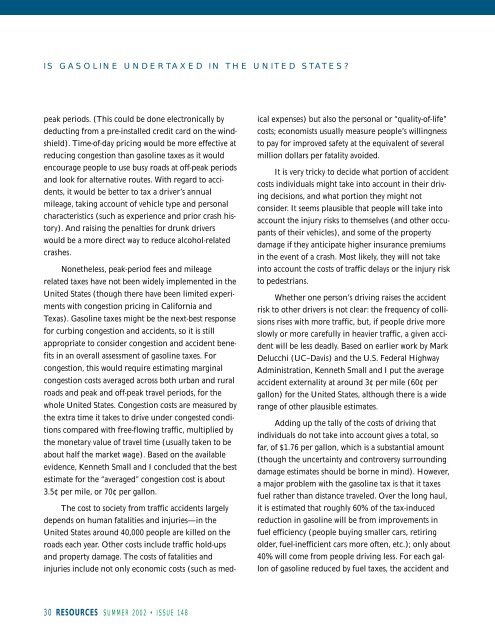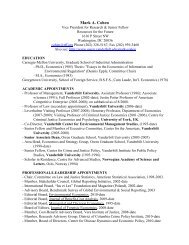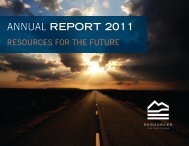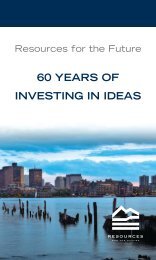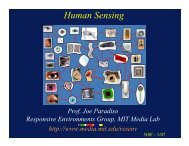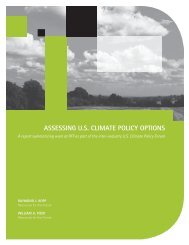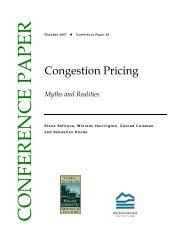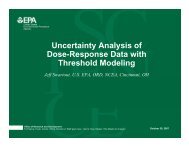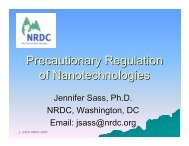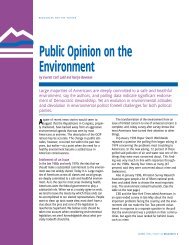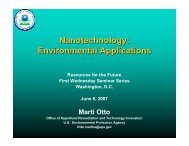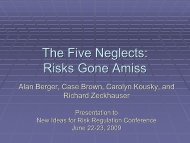Resources: Summer 2002; Issue 148 - Resources for the Future
Resources: Summer 2002; Issue 148 - Resources for the Future
Resources: Summer 2002; Issue 148 - Resources for the Future
Create successful ePaper yourself
Turn your PDF publications into a flip-book with our unique Google optimized e-Paper software.
IS GASOLINE UNDERTAXED IN THE UNITED STATES?<br />
peak periods. (This could be done electronically by<br />
deducting from a pre-installed credit card on <strong>the</strong> windshield).<br />
Time-of-day pricing would be more effective at<br />
reducing congestion than gasoline taxes as it would<br />
encourage people to use busy roads at off-peak periods<br />
and look <strong>for</strong> alternative routes. With regard to accidents,<br />
it would be better to tax a driver’s annual<br />
mileage, taking account of vehicle type and personal<br />
characteristics (such as experience and prior crash history).<br />
And raising <strong>the</strong> penalties <strong>for</strong> drunk drivers<br />
would be a more direct way to reduce alcohol-related<br />
crashes.<br />
None<strong>the</strong>less, peak-period fees and mileage<br />
related taxes have not been widely implemented in <strong>the</strong><br />
United States (though <strong>the</strong>re have been limited experiments<br />
with congestion pricing in Cali<strong>for</strong>nia and<br />
Texas). Gasoline taxes might be <strong>the</strong> next-best response<br />
<strong>for</strong> curbing congestion and accidents, so it is still<br />
appropriate to consider congestion and accident benefits<br />
in an overall assessment of gasoline taxes. For<br />
congestion, this would require estimating marginal<br />
congestion costs averaged across both urban and rural<br />
roads and peak and off-peak travel periods, <strong>for</strong> <strong>the</strong><br />
whole United States. Congestion costs are measured by<br />
<strong>the</strong> extra time it takes to drive under congested conditions<br />
compared with free-flowing traffic, multiplied by<br />
<strong>the</strong> monetary value of travel time (usually taken to be<br />
about half <strong>the</strong> market wage). Based on <strong>the</strong> available<br />
evidence, Kenneth Small and I concluded that <strong>the</strong> best<br />
estimate <strong>for</strong> <strong>the</strong> “averaged” congestion cost is about<br />
3.5¢ per mile, or 70¢ per gallon.<br />
The cost to society from traffic accidents largely<br />
depends on human fatalities and injuries—in <strong>the</strong><br />
United States around 40,000 people are killed on <strong>the</strong><br />
roads each year. O<strong>the</strong>r costs include traffic hold-ups<br />
and property damage. The costs of fatalities and<br />
injuries include not only economic costs (such as medical<br />
expenses) but also <strong>the</strong> personal or “quality-of-life”<br />
costs; economists usually measure people’s willingness<br />
to pay <strong>for</strong> improved safety at <strong>the</strong> equivalent of several<br />
million dollars per fatality avoided.<br />
It is very tricky to decide what portion of accident<br />
costs individuals might take into account in <strong>the</strong>ir driving<br />
decisions, and what portion <strong>the</strong>y might not<br />
consider. It seems plausible that people will take into<br />
account <strong>the</strong> injury risks to <strong>the</strong>mselves (and o<strong>the</strong>r occupants<br />
of <strong>the</strong>ir vehicles), and some of <strong>the</strong> property<br />
damage if <strong>the</strong>y anticipate higher insurance premiums<br />
in <strong>the</strong> event of a crash. Most likely, <strong>the</strong>y will not take<br />
into account <strong>the</strong> costs of traffic delays or <strong>the</strong> injury risk<br />
to pedestrians.<br />
Whe<strong>the</strong>r one person’s driving raises <strong>the</strong> accident<br />
risk to o<strong>the</strong>r drivers is not clear: <strong>the</strong> frequency of collisions<br />
rises with more traffic, but, if people drive more<br />
slowly or more carefully in heavier traffic, a given accident<br />
will be less deadly. Based on earlier work by Mark<br />
Delucchi (UC–Davis) and <strong>the</strong> U.S. Federal Highway<br />
Administration, Kenneth Small and I put <strong>the</strong> average<br />
accident externality at around 3¢ per mile (60¢ per<br />
gallon) <strong>for</strong> <strong>the</strong> United States, although <strong>the</strong>re is a wide<br />
range of o<strong>the</strong>r plausible estimates.<br />
Adding up <strong>the</strong> tally of <strong>the</strong> costs of driving that<br />
individuals do not take into account gives a total, so<br />
far, of $1.76 per gallon, which is a substantial amount<br />
(though <strong>the</strong> uncertainty and controversy surrounding<br />
damage estimates should be borne in mind). However,<br />
a major problem with <strong>the</strong> gasoline tax is that it taxes<br />
fuel ra<strong>the</strong>r than distance traveled. Over <strong>the</strong> long haul,<br />
it is estimated that roughly 60% of <strong>the</strong> tax-induced<br />
reduction in gasoline will be from improvements in<br />
fuel efficiency (people buying smaller cars, retiring<br />
older, fuel-inefficient cars more often, etc.); only about<br />
40% will come from people driving less. For each gallon<br />
of gasoline reduced by fuel taxes, <strong>the</strong> accident and<br />
30 RESOURCES SUMMER <strong>2002</strong> • ISSUE <strong>148</strong>


